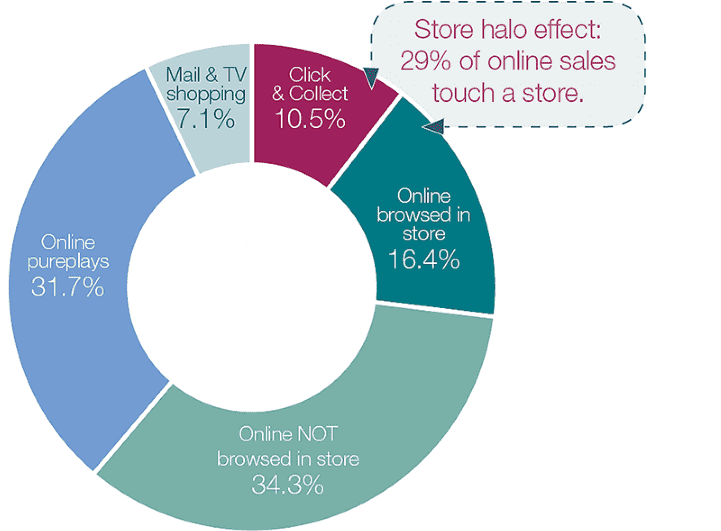Ecommerce doesn’t suit all brands
The overall growth trend of ecommerce does not account for the huge disparity between the internet offer and performance of different brands, different retail subsectors and different kinds of shopping centre. There is clear difference in the relationship that community shopping centres have with ecommerce through the brands represented within them, compared with prime retail destinations.
While many retailers have embraced omnichannel, the need for an online strategy is not universal and there remain those that do not see it as essential to meeting the needs of their customers, or have only implemented it at the margins. Compare Primark, who’s confidence in providing a great in-store experience and affordable clothing offer has so far meant avoiding ecommerce, while New Look’s online business is estimated to be 18% of UK sales.
Our analysis indicates that ecommerce plays a smaller role in the total revenues for brands in community schemes than in prime regional centres. Around 50% of ‘Top100’ brands in community schemes are value, convenience, F&B or service orientated, and ecommerce tends to represent a smaller proportion of these brands’ sales.
As such, almost 1/3 of Top100 brands in community schemes have no internet offer at all. Could it be that online competition is of less significance to retailers in community shopping centres?
The online offer of brands in community schemes
For brands with an online channel, the contribution this makes to total brand sales varies significantly. This is of course partly due to varying degrees of success in growing an ecommerce strategy, but it also indicates that for some brands online does not sufficiently replicate the in-store offer.
Of the Top100 brands in community shopping centres, 68% have an online channel, accounting for an average of 12% of their UK sales. In regional malls, 80% of the Top100 have an online offer, with an average 20% of all sales for those brands from online.
Across different goods sectors, such as variety stores, footwear, ladieswear and menswear, average online sales for key brands in community schemes are typically half that of brands in regional schemes. Furthermore, the proportion of internet sales by sector in community schemes are all well below the national average for ecommerce.
Fashion brands, which account for 20% of community mall and over 50% of regional Top100 brands, tend to have the most advanced online businesses and as such have the highest online contribution to their UK sales. The top 10 fashion brands in community schemes have an average of 12% sales online, while in regional schemes the average is 24%. This difference is predominantly a reflection of the type of fashion brands present; in community schemes 9/10 fashion brands are Value, while in regional schemes 6/10 are Aspirational and 4/10 Mass.
.png)
.png)
.png)

.png)
.jpg)
.jpg)